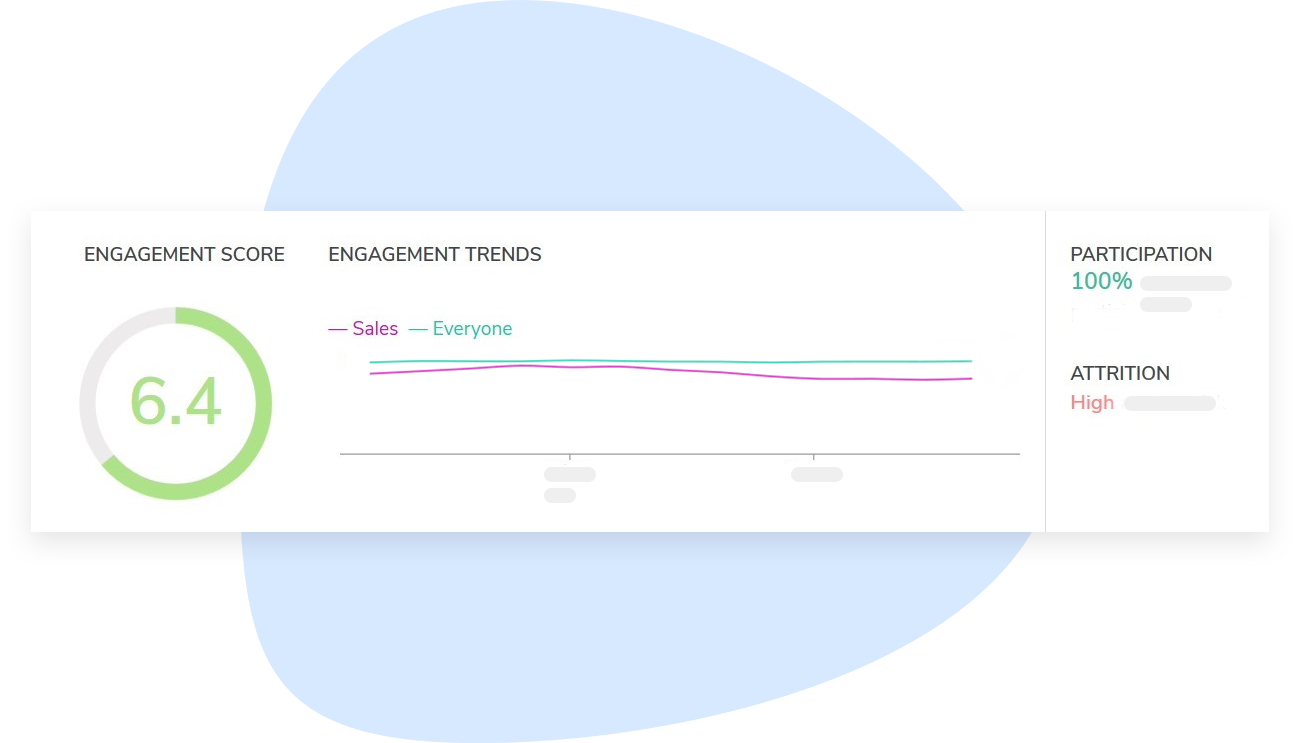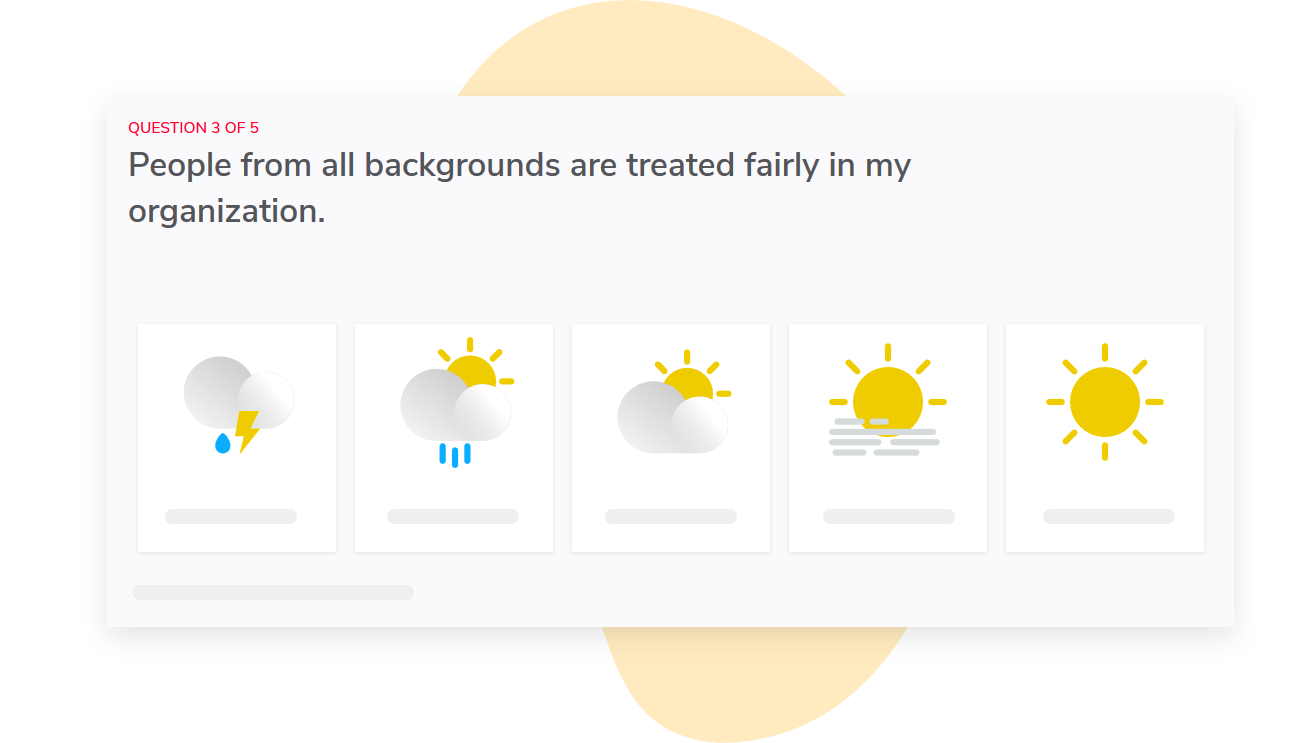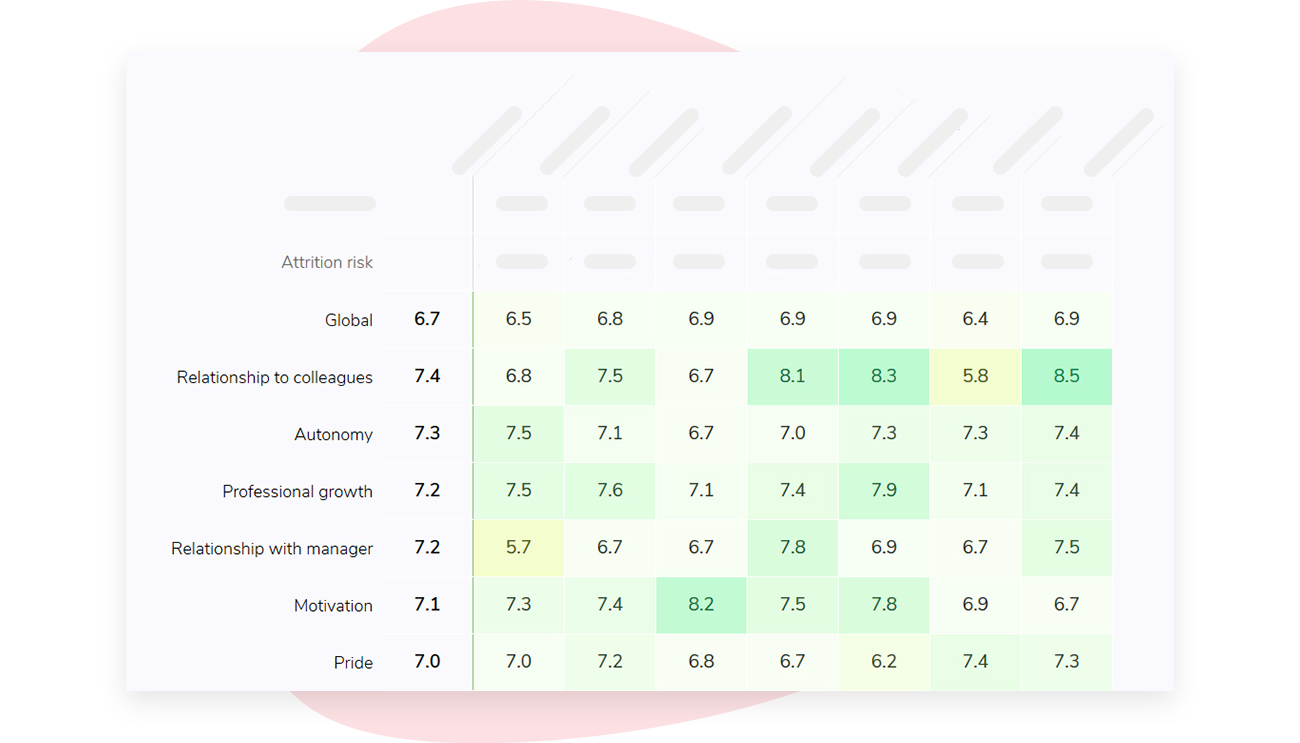匿名従業員フィードバックツール
Sparkbayで正確かつ頻繁な従業員フィードバックを取得する
従業員フィードバックは組織の成長と成功の鍵ですが、従業員は意見を言うことに多くの不安を持っています。 Sparkbayは従業員からの匿名フィードバック収集を自動化し、リアルタイム分析で即対応を可能にします。
当社の従業員フィードバックツールがエンゲージメントを改善する方法
リアルタイムインサイト
Sparkbayは組織内のすべての従業員からフィードバックを収集します。
従来の調査とは異なり、Sparkbayのパルス調査は数分で完了し、データを即時に提供します。

匿名の従業員フィードバックを収集
従業員が率直なフィードバックを共有し、普段はしない会話を促進しましょう。

データに基づく意思決定を行う
正しい意思決定は成功に不可欠です。
Sparkbayのインタラクティブダッシュボードは、各従業員セグメントに対してリーダーに実用的な洞察を提供します: 直属の上司、部署、オフィス、勤続年数、役職、人口統計など。

フィードバックに基づいて行動:サイクルを完了
従業員フィードバックの収集は始まりに過ぎません。
Sparkbayはマネージャーをチーム内の変革推進者に変え、実行可能でパーソナライズされた推奨を提供します。

従業員のプライバシーを重視する匿名フィードバックツール
- Sparkbayの匿名フィードバックツールにおける従業員とのすべての接点は100%匿名です。
- 従業員は機密性の高い調査を通じて匿名で意見を述べることができます。
- 高度に匿名かつ機密性の高い社員エンゲージメント調査。
- 従業員を保護するGDPR準拠の匿名フィードバックツール。
従業員エンゲージメントを向上させる
実際の動作を見るAnonymous employee feedback tool FAQ
What is an anonymous feedback tool for employees?
An anonymous feedback tool for employees is a platform or software that allows employees to provide feedback to their employer or manager anonymously, without revealing their identity. The aim of such tools is to encourage open and honest communication between employees and management, as employees may be more likely to share their thoughts and opinions if they do not have to fear retribution or negative consequences.
How do I create an anonymous feedback survey?
To create an anonymous feedback survey, you can follow these steps:
- Determine the purpose and goals of the survey: Start by figuring out why you want to gather feedback and what specific information you are looking to obtain. This will help guide the design and content of the survey.
- Design the survey: Keep the survey questions concise and focused. Consider using multiple-choice questions, rating scales, or open-ended questions to gather a range of feedback. Make sure to keep the survey anonymous by not asking for personal information or names.
- Distribute the survey: Once the survey is designed, send it out to your employees using the survey platform's distribution options. Consider using an anonymous email service or anonymous links to further protect the anonymity of the survey participants.
- Analyze the results: Review the survey results and identify any patterns or trends. Use the feedback to improve your workplace and create a better work environment for your employees.
Note: It is important to keep the promise of anonymity to increase the trust and confidence of employees in the feedback process.
Is an anonymous feedback tool effective for employee engagement?
Anonymous feedback tools can be effective for employee engagement, as they provide a safe and secure way for employees to share their thoughts and opinions without fear of retribution. This can lead to more open and honest communication, which can help to identify areas for improvement and create a more positive workplace culture.
However, it's important to keep in mind that anonymous feedback is just one tool for improving employee engagement. It should be used in conjunction with other engagement strategies, such as regular one-on-one meetings with managers, employee recognition programs, and opportunities for growth and development.
It's also crucial to follow up on anonymous feedback by addressing concerns and making changes, where appropriate, to show that the feedback is valued and taken seriously. This can help to build trust and increase employee engagement in the long term.
Why should employee feedback be anonymous?
There are several reasons why making an employee survey anonymous can be beneficial:
- Increased honesty: Employees may be more likely to provide honest and candid feedback if they are not afraid of retaliation or negative consequences. An anonymous survey allows employees to share their opinions freely, without the fear of being identified.
- Improved participation: Employees may be more likely to participate in the survey if they feel their privacy and confidentiality are protected. An anonymous survey can increase participation rates and provide a more accurate picture of employee satisfaction and engagement.
- Enhanced trust: By keeping the survey anonymous, employees can feel more confident that their feedback will be taken seriously and used to make positive changes in the workplace. This can help to build trust and strengthen the relationship between employees and management.
- Reduced bias: Anonymity can help to reduce bias and eliminate the influence of personal relationships, power dynamics, or other factors that might impact the results of a survey.
- More accurate results: When employees are free to provide feedback without fear of retribution, the results of the survey are more likely to reflect their true opinions and experiences. This can provide valuable insight into areas that need improvement and help to inform decisions that can drive positive change in the workplace.
How do you gather staff feedback?
There are several ways to gather staff feedback, including:
- Surveys: Surveys can be administered online or in person and can be designed to gather feedback on specific topics or the overall work environment. They can be anonymous or include personal information, depending on your goals and the nature of the feedback you are seeking.
- One-on-one meetings: Regular one-on-one meetings with managers or supervisors can provide an opportunity for employees to share their thoughts and opinions in a more personal setting.
- Focus groups: Focus groups bring together a small group of employees to discuss specific topics or areas of concern. This can provide more in-depth and nuanced feedback and can also be a useful tool for brainstorming solutions and ideas.
- Employee suggestion boxes: Employee suggestion boxes can be used to collect feedback in a confidential and anonymous manner. This can provide employees with a convenient and low-stakes way to share their thoughts and ideas.
- Employee engagement software: Employee engagement software can provide real-time feedback, pulse surveys, and engagement analytics. This can help to identify areas for improvement, track changes over time, and measure the impact of engagement initiatives.
It's important to choose the method that best fits the needs and culture of your organization and to follow up on the feedback received to demonstrate that it is valued and being used to drive positive change.
How to track employee feedback ?
To track employee feedback effectively, you can use the following steps:
- Create a system: Develop a consistent and centralized system for tracking feedback, such as a spreadsheet or a specialized software platform. This will help to ensure that all feedback is captured and can be easily accessed and analyzed.
- Assign responsibility: Assign someone to be responsible for tracking and analyzing feedback, whether it's a dedicated HR or management team member or an external consultant. This person should be responsible for reviewing and categorizing feedback, and tracking progress and changes over time.
- Monitor progress: Regularly monitor progress and analyze the feedback received to identify trends and areas for improvement. This can help to identify successes, as well as areas that need more attention, and inform decision making and actions to drive positive change.
- Communicate with employees: Regularly communicate with employees about the feedback received, the actions taken, and the impact of the changes made. This can help to build trust and demonstrate the value of feedback, and increase employee engagement.
- Evaluate the system: Regularly evaluate the system for tracking employee feedback to ensure it is effective and efficient. Consider making changes to improve the process, such as adding new categories, streamlining the data analysis process, or incorporating new feedback methods.
Tracking employee feedback is an ongoing process that requires a commitment to continuous improvement and open communication. By creating a system, assigning responsibility, monitoring progress, communicating with employees, and evaluating the system, you can effectively track feedback and use it to drive positive change in your workplace.
How employee feedback can help your organization?
Employee feedback can help a company in several ways:
- Improving performance and productivity: Feedback can provide employees with specific suggestions for how to improve their work, which can lead to increased performance and productivity.
- Promoting a positive work culture: When employees feel heard and valued, they are more likely to be engaged and committed to their work.
- Identifying areas for growth: Feedback can help companies identify areas where they need to improve, such as communication, leadership, or processes.
- Retaining employees: When employees feel that their feedback is valued and acted upon, they are more likely to stay with the company long-term.
- Improving decision-making: Gathering feedback from employees can provide valuable insights and perspectives that can inform decision-making at all levels of the company.
Overall, collecting and acting upon employee feedback can have a positive impact on employee satisfaction, engagement, and performance, leading to improved overall business results.
Why use an anonymous employee feedback tool?
An employee feedback tool can be beneficial for several reasons:
- Encourages honest feedback: Employees may be more likely to share their true thoughts and opinions when they can do so anonymously, without fear of retaliation.
- Reduces bias: An anonymous feedback tool eliminates the influence of personal relationships, allowing for a more objective view of employee experiences and opinions.
- Increases employee engagement: When employees feel that their opinions are valued and taken into consideration, they are more likely to be engaged and invested in their work.
- Provides a safe space for constructive criticism: An anonymous feedback tool allows employees to raise sensitive issues and make suggestions for improvement without fear of negative consequences.
- Improves the accuracy of feedback: By removing the influence of personal relationships and bias, anonymous feedback can provide a more accurate picture of employee experiences and opinions.
Overall, using an anonymous employee feedback tool can help companies gather valuable insights and improve employee engagement, leading to improved overall business results.
How many questions should be in a Pulse survey?
If a pulse survey is short and sweet and can be distributed several times per year, how long should each pulse survey be? This depends on the cadence(how often you’re distributing it. As a rule of thumb, you can use the numbers below and adjust based on your organization’s needs:
- Bi-weekly pulse survey: 5 questions per survey
- Monthly pulse survey: 10 questions per survey
- Quarterly pulse survey: 15 questions per survey
What is the ideal pulse survey frequency?
Pulse surveys are nice, short, and sweet, so it’s hard to figure out how often you should use them.On the one hand, you want to use them often enough to capture trend data.On the other hand, you don’t want to overwhelm your teams with so many pulse surveys that they stop doing them. Take the following factors into consideration when deciding how often to distribute your pulse surveys.
- How frequently the metrics you are measuring are likely to fluctuate
- How fast you can absorb and analyze results
- How fast you can implement action plans
- How often are other organizational metrics reported?
Are pulse surveys anonymous?
Yes.By maintaining anonymity, employees can share their honest feelings with confidence.Sparkbay's Pulse Survey reports do not display individual answers; only aggregated results are displayed. For managers to see the results of a team, at least five employees need to have completed a survey.
